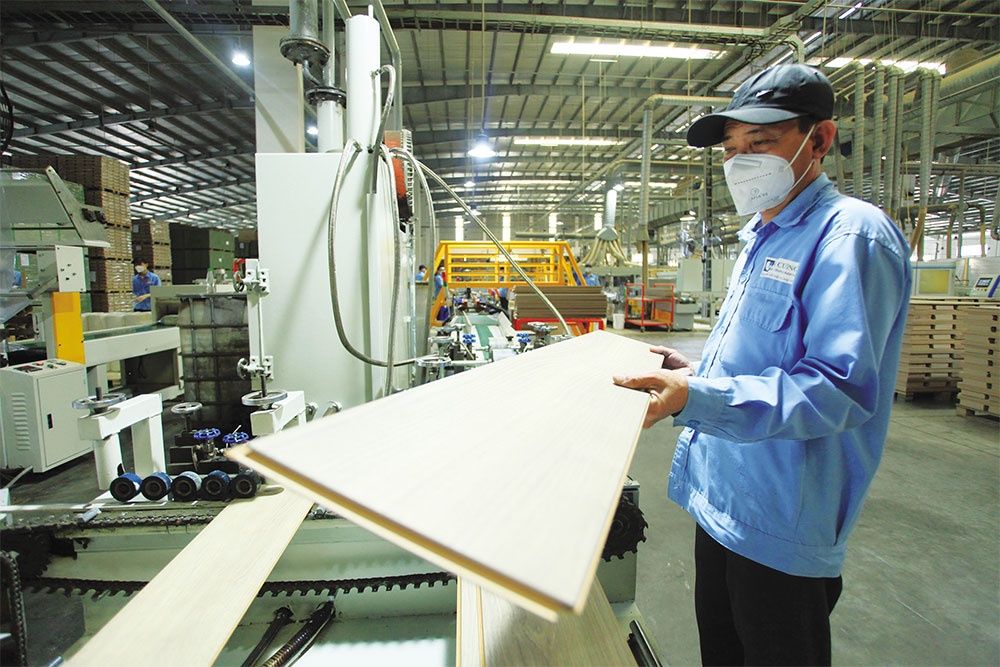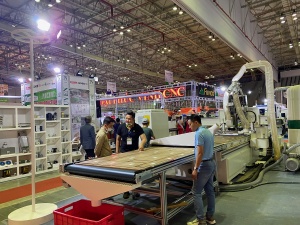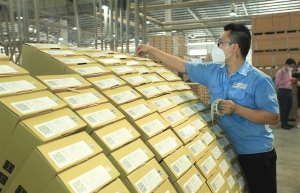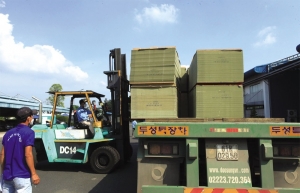Crucial certification needed to expand wood market
Although it is pricier, Tekcom Company in the southern province of Binh Duong has almost completed the year-end orders by purchasing FSC-certified rubber wood. However, other wood processing enterprises are experiencing skyrocketing costs as the demand for products with FSC certification in Europe and the US increases rapidly.
According to many businesses, the consequence is that they risk not being able to meet current and future demand for FSC timber. The most likely scenarios are failure to meet customer requirements, factory capacity reduction, labour loss, and uncertainty in revenues and profits in the coming year.
Nguyen Hai, head of Procurement at Tekcom, found that the shortage of domestic FSC wood sources is limiting many export enterprises in terms of the raw materials.
Tekcom is seeking further sources of FSC timber, both domestically and imported from neighbouring countries. The import of certified acacia wood from Laos helps the firm reduce the pressure, but the improvement is only temporary.
The demand for 18,000cu.m per month of raw wood, including FSC and other legal sources, is not always met. Meanwhile, ensuring long-term supply from Laos remains difficult.
“We have not been able to develop the rubber wood material area in the Central Highlands or pine in the southeast of the country,” Hai said, adding that she would regret not renewing the rubber wood FSC certification.
 |
| Crucial certification needed to expand wood market, photo Le Toan |
Vietnam has a large rubber areas, with 939,000 hectares in 2021, said the Vietnam Rubber Association. But so far, none has achieved FSC certification.
At Tekcom, exports slowed down six months ago. “We are shifting to high-quality products, aiming to replace Russia’s market share of plywood in the world market,” Hai said. “Tekcom will also build a new factory in the south-central province of Binh Dinh next year to take advantage of the FSC-affected glue material area of the central and northern regions.”
However, Hai also admitted that these plans do not fill the current shortage of FSC materials. Concerns about the supply of FSC wood in Vietnam are leading to a lack of initiative in raw materials for processing enterprises, especially those exporting to the US and EU.
The increased demand also complicates the situation, forcing businesses to import to make up for the shortfall in the country. Nhat Nam Construction Plywood Co., Ltd. in Binh Duong is importing beech from France to produce chairs for Starbucks and McDonald’s in the US.
“FSC wood requirements account for about a quarter of the company’s orders,” said Nguyen Minh Nhat, director of the firm. “Products using ingredients with FSC certification are selling also for a quarter more than conventional alternatives. However, consumers around the world, especially in the European and North American markets, only use products when they know for sure that it is not created because of any deforestation.”
There are two sustainability certification systems in the world, the Programme for the Endorsement of Forest Certification (PEFC) and FSC. To achieve any of these certifications, plantation companies or households must meet stringent environmental, social, and economic criteria.
Nguyen Van Dien, director of the Forestry Production Development Department under the Ministry of Agriculture and Rural Development’s Vietnam Administration of Forestry, said that the forestry industry has developed the Vietnam Forest Certification System (VFCS), which is PEFC-accredited.
By the end of March, Vietnam had 53 afforestation units, with over 226,000ha of FSC-certified forests and nearly 55,000ha of VFCS-certified forests.
“The implementation and maintenance of FSC certification by afforestation units are encumbered with many obstacles, coming from the four main barriers of land, technology, market, and policies.
Currently, the timber yield of FSC forests is not high, only accounting for 75-130cu.m per hectare as forest growers do not have access to quality forest tree seeds and do not receive detailed instructions. “Thus, they have not met the strict criteria when implementing and maintaining the FSC certificate,” Dien said.
“In the domestic market, FSC wood faces barriers that reduce competitiveness. The localities with large areas of FSC-certified plantations are mainly in the north and north-central provinces, but the demand for FSC timber in these kinds of localities is not that significant.
Meanwhile, the largest wood processing centres of Vietnam are concentrated mainly in the southeastern region. The cost of transporting FSC timber from across the country is very high, making it less competitive.”
Tran Thien, director of Thanh Hoa Co., Ltd. in Ho Chi Minh City, commented that the benefits gained by forest owners are too small compared to other stages in the chain.
“Meanwhile, the sustainability of the wood production, processing, and export chain is only counted when processors use FSC timber as priority, after they have paid at least 2-3 per cent of the product value. However, FSC growers do not have the money to pay the cost of assessing and transporting the timber to the factories.”
Thien also explained, “For FSC, the assessment cost by foreign organisations is very high and can reach up to $100,000 initially, while the annual costs also amount to over $5,000 – a massive expense for a forest grower.” As a consequence, Thien said, many planters in Quang Ngai province have abandoned the annual FSC assessment.
The government wants to foster the development of plantation timber to proactively source raw materials and reduce dependence on imported timber.
Many FSC wood development advocates believe that producers will increase investment in FSC-certified wood as profits decrease due to input constraints. At the same time, it could be easier for foreign buyers to order from Vietnam.
| - Domestic timber sources include concentrated plantation timber with about 21.5 million cu.m annually and rubber wood and scattered trees of about 9.5 million cu.m per year. About 40 per cent of the domestic supply of raw wood materials is used to process furniture for export. - Between 2012 and 2021, each year, Vietnam imported more than 4.8 million cu.m of raw wood from 100 countries and territories, with about 70 per cent being processed for export. Particularly in 2021, Vietnam imported around 6 million cu.m of round timber. - The Vietnam Administration of Forestry set a target that the export value of wood and wood products will reach $18-20 billion by 2025 and $23-25 billion by 2030. In 2021, the total domestic export value for wooden furniture and all forest products reached over $15.8 billion. |
 | Wood exports reach $12.4 billion in first nine months Vietnam exported about $12.4 billion of wood and wood products in the first nine months of 2022, an increase of 7 per cent over the same period in 2021, according to the Ho Chi Minh City Handicraft and Woodworking Association. |
 | Vietnam’s wood exporters under FSC standard pressure Weak export market demand and stable freight rates rendered some wood materials imported into Vietnam cheaper. However, FSC-certified logs imported from the EU market become more expensive for Vietnamese manufacturers, forcing them to look at home-grown, certified solutions. |
 | VAT refund delays cause fear of bad debt for wood groups As VAT refunds represent a crucial part of the cash flow of timber processors, the current delay is throwing a wrench in the operations of woodchip, furniture, and other timber-based producers, leading related associations to call for easier regulations. |
What the stars mean:
★ Poor ★ ★ Promising ★★★ Good ★★★★ Very good ★★★★★ Exceptional
 Tag:
Tag:
Related Contents
Latest News
More News
- Businesses ramp up production as year-end orders surge (December 30, 2025 | 10:05)
- Vietjet chairwoman awarded Labour Hero title (December 29, 2025 | 13:06)
- How to unlock ESG value through green innovation (December 29, 2025 | 10:03)
- AI reshapes media and advertising industry (December 29, 2025 | 08:33)
- FPT and GELEX sign deal to develop blockchain tech for global markets (December 29, 2025 | 08:29)
- Vietnam’s GDP forecast to grow by 9 per cent in 2026 (December 29, 2025 | 08:29)
- Women entrepreneurs are key to Vietnam’s economic growth (December 29, 2025 | 08:00)
- Vietnam's top 500 value-creating enterprises announced (December 27, 2025 | 08:00)
- The PAN Group shaping a better future with ESG strategy (December 26, 2025 | 09:00)
- Masan Consumer officially lists on HSX, marking the next phase of value creation (December 25, 2025 | 13:20)























 Mobile Version
Mobile Version